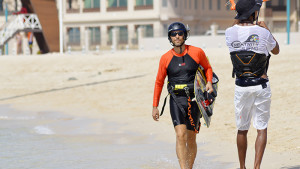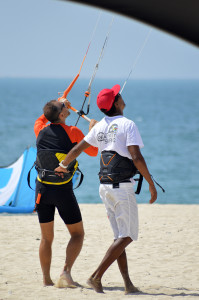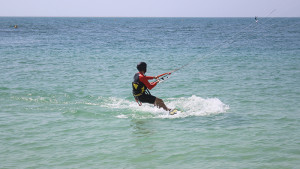Kitesurfing is a sport with almost infinite appeal. Your first goal is to master the kiting basics and learn about the ‘wind window’. This involves working with no board, only the trainer kite
In the last couple of years, a community of Kitesurf and Windsurf aficionados has grown in the UAE. Every weekend there are excursions; an opportunity to go looking for waves and wind, to share a common passion, and to appreciate the beauty of this country. I first discovered this sport and saw kite surfers in action here in Dubai some years ago; it was not until three years later that I had my first kitesurf lesson.
Ninety percent of kite boarding is kite control. So to start with, my instructor, Hisham, delivered a beach-based lesson that allowed me to practice with special training kites that have short, easy-to-control lines. The key is to keep an eye on the 180-degree arc in the sky that the kite flies in, called the ‘wind window’.
In the beginning, it’s all about the kite. Learning good kite flying skills with a trainer kite before taking lessons will save you money and a lot of frustration. So get a trainer and practice, practice… and practice again. Trainer kites are small (2.5m to 3.5m) and are designed to be flown on the beach, in a field, water or any wide open area.
Once in the water, before strapping on a board, you’ll practice controlling the kite as it drags your body through the water. After practicing with body dragging, you are ready for your first water start. That progression gave me such excitement! I steered the kite into the power zone, got yanked out of the water and started planning, then accelerated until I wiped out. Even though at the beginning you are not able to dive your kite for long, immediately you feel pure freedom.
Start your run with the board pointed about 45 degrees downwind toward the kite; there will be less resistance than with a sideways board and it’ll be easier to get up. While keeping the kite hovering at the neutral noon position, carefully slip your feet into the board’s foot straps. Aim the board slightly downwind, and then dive the kite hard while driving your weight through your hips, legs and feet. Once you’re standing upright, dive the kite again to accelerate and get your board planing. Now lean back at a 45-degree angle and, depending on which direction you’re riding, park the kite at either the 11 o’clock or 2 o’clock position.
Riding upwind returns you to the beach at the same spot you entered the water. To do this, fly the kite low and maintain even power. While edging against the kite, lean back, then swivel your hips and upper body in the direction you want to take. Push down on your back foot to keep your edge from slipping down-wind. The first goal for a beginner is to end up in the same point where you started from.
The basic equipment includes:
• A kite, available in two major forms. Kites come in sizes ranging from 0.7 square meters to 21 square meters, or even larger. In general, the larger the surface area, the more power the kite has. Kite power is also directly linked to speed, and smaller kites can be flown faster in stronger winds. Seasoned kite boarders will likely have three or more kite sizes which are needed to accommodate various wind levels.
• Flying lines are made of a very strong material in order to handle the dynamic load in unpredictable wind while maintaining a small cross-sectional profile to minimise drag.
• The control bar is a solid metal or composite bar which attaches to the kite via the lines. The rider holds on to this bar and controls the kite by pulling at its ends, causing the kite to rotate clockwise or counter-clockwise like a bicycle.
• The harness together with a spreader bar attaches the rider to the control bar. By hooking in, the harness takes most of the strain of the kite’s pull off of the rider’s arms, and spreads it across a portion of his body.
• The board. There are now several types of kiteboards; some kite surfers also use standard surfboards, or even long boards, although without foot straps much of the high-jump capability of a kite is lost.
• A safety hook knife is considered required equipment.
Extra equipment may include: a wetsuit or a drysuit, a helmet with or without a communication system (the one we tried had a 2 way communication system, which was very useful as you need to talk to your instructor while diving the kite), a personal flotation device (PFD), an impact vest, a GPS, signaling devices. Kiters in fact don’t use leashes; the slingshot effect can be skull-cracking.
With thanks to Creativity Surfing LLC. The school uses equipment exclusively from RRD (Roberto Ricci Design), the major Italian brand for water sports. Creativity Surfing is also an authorized RRD reseller: for those looking for
quality equipment, the school allows you to try out the equipment before buying it. www.creativitysurfing.com
Words by: Nico de Corato
Photos by: Creativity Surfing & DubaiBlog




